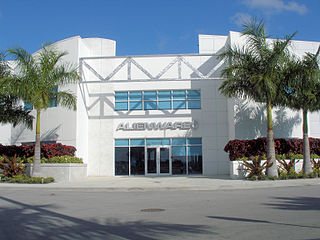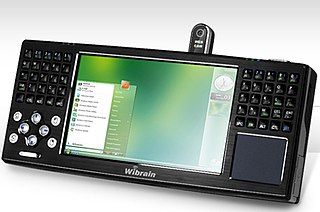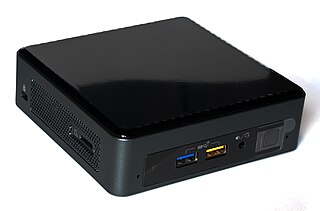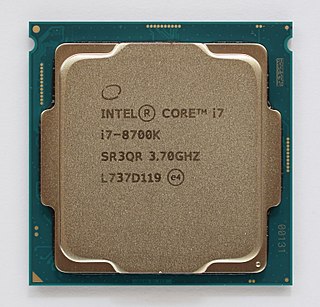Related Research Articles

Celeron is a discontinued series of low-end IA-32 and x86-64 computer microprocessor models targeted at low-cost personal computers, manufactured by Intel. The first Celeron-branded CPU was introduced on April 15, 1998, and was based on the Pentium II.

Centrino is a brand name of Intel Corporation which represents its Wi-Fi and WiMAX wireless computer networking adapters. Previously the same brand name was used by the company as a platform-marketing initiative. The change of the meaning of the brand name occurred on January 7, 2010. The Centrino was replaced by the Ultrabook.

Alienware Corporation is an American computer hardware subsidiary brand of Dell. Their product range is dedicated to gaming computers and accessories and can be identified by their alien-themed designs. Alienware was founded in 1996 by Nelson Gonzalez and Alex Aguila. The development of the company is also associated with Frank Azor (co-founder), Arthur Lewis, Joe Balerdi, and Michael S. Dell (CEO). The company's corporate headquarters is located in The Hammocks, Miami, Florida.

Dell XPS is a line of consumer-oriented laptop and desktop computer series manufactured by Dell since 1993.

An ultra-mobile PC, or ultra-mobile personal computer (UMPC), is a miniature version of a pen computer, a class of laptop whose specifications were launched by Microsoft and Intel in Spring 2006. Sony had already made a first attempt in this direction in 2004 with its Vaio U series, which was only sold in Asia. UMPCs are generally smaller than subnotebooks, have a TFT display measuring (diagonally) about 12.7 to 17.8 centimetres, are operated like tablet PCs using a touchscreen or a stylus, and can also have a physical keyboard. There is no clear boundary between subnotebooks and ultra-mobile PCs, but UMPCs commonly have major features not found in the common clamshell laptop design, such as small keys on either side of the screen, or a slide-out keyboard.
Tick–tock was a production model adopted in 2007 by chip manufacturer Intel. Under this model, every microarchitecture change (tock) was followed by a die shrink of the process technology (tick). It was replaced by the process–architecture–optimization model, which was announced in 2016 and is like a tick–tock cycle followed by an optimization phase. As a general engineering model, tick–tock is a model that refreshes one side of a binary system each release cycle.

Intel Core is a line of multi-core central processing units (CPUs) for midrange, embedded, workstation, high-end and enthusiast computer markets marketed by Intel Corporation. These processors displaced the existing mid- to high-end Pentium processors at the time of their introduction, moving the Pentium to the entry level. Identical or more capable versions of Core processors are also sold as Xeon processors for the server and workstation markets.

Skylake is Intel's codename for its sixth generation Core microprocessor family that was launched on August 5, 2015, succeeding the Broadwell microarchitecture. Skylake is a microarchitecture redesign using the same 14 nm manufacturing process technology as its predecessor, serving as a tock in Intel's tick–tock manufacturing and design model. According to Intel, the redesign brings greater CPU and GPU performance and reduced power consumption. Skylake CPUs share their microarchitecture with Kaby Lake, Coffee Lake, Whiskey Lake, and Comet Lake CPUs.
Cannon Lake is Intel's codename for the 10 nm die shrink of the Kaby Lake microarchitecture. As a die shrink, Cannon Lake is a new process in Intel's process-architecture-optimization execution plan as the next step in semiconductor fabrication. Cannon Lake CPUs are the first mainstream CPUs to include the AVX-512 instruction set.

Next Unit of Computing (NUC) is a line of small-form-factor barebone computer kits designed by Intel. It was previewed in 2012 and launched in early 2013. The NUC has developed over ten generations, spanning from Sandy Bridge-based Celeron CPUs in the first generation through Ivy Bridge-based Core i3 and i5 CPUs in the second generation to Gemini Lake-based Pentium and Celeron CPUs and Kaby Lake-based Core i3, i5, and i7 CPUs in the seventh and eighth generations. The NUC motherboard usually measures approximately 10 × 10 centimetres (4 × 4 in), although some models have had different dimensions.

Kaby Lake is Intel's codename for its seventh generation Core microprocessor family announced on August 30, 2016. Like the preceding Skylake, Kaby Lake is produced using a 14 nanometer manufacturing process technology. Breaking with Intel's previous "tick–tock" manufacturing and design model, Kaby Lake represents the optimized step of the newer process–architecture–optimization model. Kaby Lake began shipping to manufacturers and OEMs in the second quarter of 2016, with its desktop chips officially launched in January 2017.
Ice Lake is Intel's codename for the 10th generation Intel Core mobile and 3rd generation Xeon Scalable server processors based on the Sunny Cove microarchitecture. Ice Lake represents an Architecture step in Intel's process–architecture–optimization model. Produced on the second generation of Intel's 10 nm process, 10 nm+, Ice Lake is Intel's second microarchitecture to be manufactured on the 10 nm process, following the limited launch of Cannon Lake in 2018. However, Intel altered their naming scheme in 2020 for the 10 nm process. In this new naming scheme, Ice Lake's manufacturing process is called simply 10 nm, without any appended pluses.
Tiger Lake is Intel's codename for the 11th generation Intel Core mobile processors based on the Willow Cove Core microarchitecture, manufactured using Intel's third-generation 10 nm process node known as 10SF. Tiger Lake replaces the Ice Lake family of mobile processors, representing an optimization step in Intel's process–architecture–optimization model.

Coffee Lake is Intel's codename for its eighth-generation Core microprocessor family, announced on September 25, 2017. It is manufactured using Intel's second 14 nm process node refinement. Desktop Coffee Lake processors introduced i5 and i7 CPUs featuring six cores and Core i3 CPUs with four cores and no hyperthreading.

The Dell Inspiron series is a line of laptop computers made by American company Dell under the Dell Inspiron branding. The first Inspiron laptop model was introduced before 1999. Unlike the Dell Latitude line, which is aimed mostly at business/enterprise markets, Inspiron is a consumer-oriented line, often marketed towards individual customers as computers for everyday use.

The ThinkPad P series line of workstation laptops produced by Lenovo and was introduced by the company as a successor to the previous ThinkPad W series. With 15.6" and 17.3" screens, the ThinkPad P series saw the reintroduction of physically large laptops into the ThinkPad line. Marketed largely as portable workstations, many P series laptops can be configured with high-end mobile workstation-class Intel processors as well as error correction code (ECC) memory and a discrete Nvidia Quadro GPU. The P series offers independent software vendor (ISV) certifications from software vendors such as Adobe and Autodesk for various computer-aided design (CAD) software. The P52 and P72 models are the last current Lenovo laptops with a dedicated magnesium structural frame.
Comet Lake is Intel's codename for its 10th generation Core processors. They are manufactured using Intel's third 14 nm Skylake process revision, succeeding the Whiskey Lake U-series mobile processor and Coffee Lake desktop processor families. Intel announced low-power mobile Comet Lake-U CPUs on August 21, 2019, H-series mobile CPUs on April 2, 2020, desktop Comet Lake-S CPUs April 30, 2020, and Xeon W-1200 series workstation CPUs on May 13, 2020. Comet Lake processors and Ice Lake 10 nm processors are together branded as the Intel "10th Generation Core" family. Intel officially launched Comet Lake-Refresh CPUs on the same day as 11th Gen Core Rocket Lake launch. The low-power mobile Comet Lake-U Core and Celeron 5205U CPUs were discontinued on July 7, 2021.

Alder Lake is Intel's codename for the 12th generation of Intel Core processors based on a hybrid architecture utilizing Golden Cove performance cores and Gracemont efficient cores. It is fabricated using Intel's Intel 7 process, previously referred to as Intel 10 nm Enhanced SuperFin (10ESF). The 10ESF has a 10%-15% boost in performance over the 10SF used in the mobile Tiger Lake processors. Intel officially announced 12th Gen Intel Core CPUs on October 27, 2021, mobile CPUs and non-K series desktop CPUs on January 4, 2022, Alder Lake-P and -U series on February 23, 2022, and Alder Lake-HX series on May 10, 2022.
References
- ↑ "New 8th Gen Intel Core Processors Optimize Connectivity, Great Performance, Battery Life for Laptops | Intel Newsroom". Intel Newsroom. Retrieved 2018-08-28.
- ↑ Cutress, Ian. "Intel Launches Whiskey Lake-U and Amber Lake-Y: New MacBook CPUs?" . Retrieved 2018-08-28.
- ↑ "Intel launches Whiskey Lake-U and Amber Lake-Y CPUs with focus on enhanced mobile connectivity". Notebookcheck. Retrieved 2018-08-28.
- ↑ "Intel launches Whiskey and Amber Lakes: Kaby Lake with better Wi-Fi, USB". Ars Technica. Retrieved 2018-08-28.
- ↑ "Intel Launches Whiskey Lake And Amber Lake CPUs for Laptops". Tom's Hardware. 2018-08-28. Retrieved 2018-08-28.